I personally enjoy Thai dishes – probably because they share many similar seasoning techniques with Vietnamese dishes. Some of them are actually very healthy, like curries. Unlike those myths you have heard of, curries don’t cause acnes or widen your waistline even when they contain many spicy ingredients like lemongrass, pepper, chili and galangal; or oily like coconut oil and coconut milk. Those spicy ingredients, in contrast, are beneficial for your digestive system, and lemongrass can even prevent cancer. Coconut oil, while contains saturated fat, also has antioxidants and can be beneficial to heart health when used moderately. So, ready to give curry a try?
There are various ways to make curry, and unfortunately they are all quite complicated. For a while, I had been resorting to packaged curry powder from Lobo – a Thai brand of seasoning mixes. The curry powder is quite good – there was no reason for me to stop using it until I realised that it is quite hard to find in Vietnam. I felt the urge to make homemade curry without curry powder, just to avoid hard time finding the Lobo package if I go back home. After some research, I gave it a shot and was amazed by the result. The Lobo mix is utterly beaten by the superior freshness and richness of the homemade recipe. The only thing you can taste in the packaged powder is an artificial sweetness and saltiness, and a bit of a sour taste. Homemade curry paste is way beyond that: it is a beautiful combination of fresh and natural ingredients, so fragrant that no words can describe.
Making curry is not easy at all, due to the fact that it requires a range of different ingredients. Good thing is that you can make a large amount of curry at once, and then store it in the fridge for a long time without losing its flavours. The recipe that I am introducing today is a simplified version, yet it still maintains the best features of a Thai Panang curry.
One final note: taste the curry as you are cooking and adjust the recipe according to your taste. Curry is such a personal pot of art. Its flavours depend significantly on the ‘artist’ – you – the chef in charge.
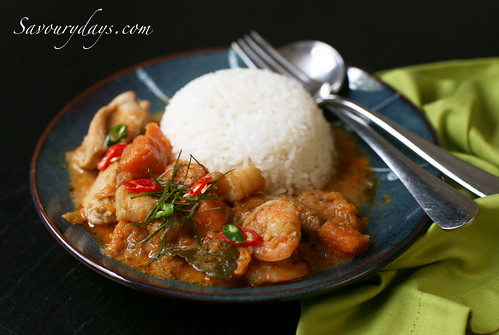
The Curry Paste
A. INGREDIENTS
- 5 grams coriander seeds – roast until fragrant (or 1 tsp ground coriander)
- 1/4 tsp (1 – 2 gr) cumin powder
- 10 grams galangal – thinly sliced
- 25 grams lemongrass – thinly sliced
- 5 grams cilantro roots – thoroughly rinse to clean off dirt
- 15 grams shallots – remove skin and finely chopped
- 15 grams garlic – remove skin and finely chopped
- 1.5 tbsp peanut butter
- 1.5 tsp shrimp paste
- 4 – 5 kaffir lime leaves
- Dried chili and chili powder (adjust to taste)
- Pepper seeds or powder
- 1 – 2 tbsp (5 ml) fish sauce (adjust to taste)
 Measuring ingredients precisely is important to this recipe because many of the ingredients are strong spices. If we get a bit more of them, even 2 -3 grams, then the taste of the whole paste will change. This is why I stated all of the ingredients in “grams” instead of subjective measurement such as 2 – 3 cloves garlic.
Measuring ingredients precisely is important to this recipe because many of the ingredients are strong spices. If we get a bit more of them, even 2 -3 grams, then the taste of the whole paste will change. This is why I stated all of the ingredients in “grams” instead of subjective measurement such as 2 – 3 cloves garlic.
B. INSTRUCTIONS
1. Notes on ingredients
– All ingredients above are essential in bringing out the Panang curry flavour. If 1 or 2 ingredients are missing, your curry will still be tasty, but no longer have the authentic taste of Panang curry.
– Traditional Panang curry contains ground roasted peanuts, which help to create the thick texture and creamy flavour of the curry paste. But if you have a hard time finding roasted peanuts at the local stores, you can use peanut butter as an alternative. If roasted peanuts are available, remove their skin and blend the peanuts into powder. Use 2-3 tbsp for your curry paste.
– To reduce the smell of shrimp paste, cover it with banana leaves and grill for a few minutes. Doing this will also help to boost the curry flavour.
– Kaffir lime leaves can be replaced with Vietnamese lime leaves, but that will change the taste of the curry slightly. If you can find kaffir lime, it will be a great idea to grate some lime zest into the curry to make the flavour of the paste more intense and bright.
– Listed above are the ingredients I used. I couldn’t find dried chilies so I just replaced it with chili powder. Yet I am pretty sure dried chilies would give the dish a more beautiful red colour.
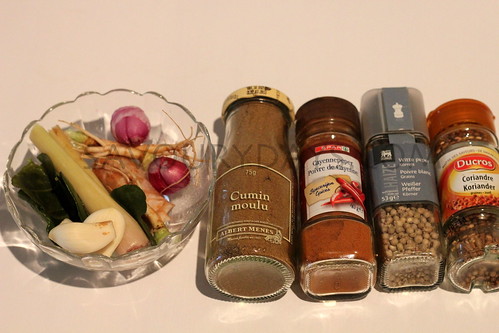
2. Making the curry paste
– Blend all ingredients together until incorporated and smooth.
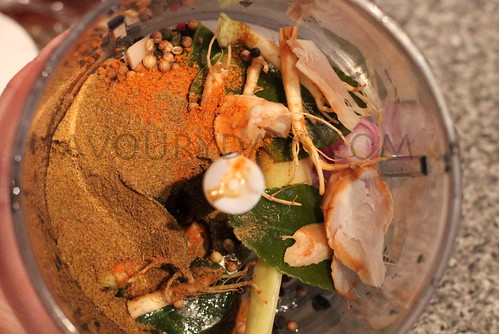
– You should blend/grind dry ingredients first until they are finely powdered. At this point, you can add wet ingredients like peanut butter, shrimp paste, fish sauce to the mixture.
– If you have a mortar and a pestle, use them instead of the food processor. Doing so will bring out more flavours from the ingredients and create a much smoother paste. The food processor actually takes longer to grind the ingredients, and it won’t deliver a result as satisfying as when you use the mortar and pestle.
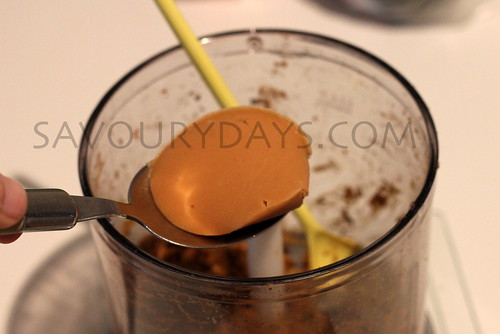
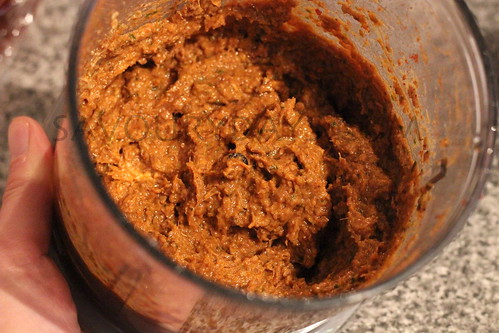
– Curry paste can be stored in a sealed jar in the fridge for 1 week, or in the freezer. The above recipe produces approximately 3 portions, each of which is enough for about 500 grams meat + 300 grams veggies.
– Once you have made the curry paste, the rest of the recipe is very simple. Although the traditional Panang curry is usually thick and contains only beef without any veggies, I have seen so many different versions that have chicken, seafood and a variety of veggies. So, just go ahead and keep experimenting until you got your favourite version of curry.
The Panang Curry
A. INGREDIENTS
- 300 grams (2/3 lb.) chicken – cut into 2.5 x 2.5 cm pieces
- 200 grams (1/2 lb.) shrimp – peeled and deveined
- 300 – 400 grams (2/3 – 1 lb.) pumpkin (remove seeds and skin) – diced into 2 x 2 cm cubes
- 1/3 curry paste prepared in part A
- 100 – 150 ml (1/2 cup) coconut milk
- 3 – 4 lime leaves – rinse thoroughly
- 1/2 – 1 lemongrass – crushed
- 300 – 400 ml (2 cups) chicken stock
- 1/2 tbsp palm sugar or brown cane sugar. White sugar is NOT a recommended substitute.
- Fish sauce or salt – to taste
- Sweet Thai basil
B. PRINTABLE RECIPE
1. Prepare the chicken, shrimp and pumpkin. I use 2 large chicken drumsticks for this recipe.
Always buy bone-in chicken. Not only is it cheaper than chicken fillets, but it is also better for value: you can debone the chicken – the meat can be used for the recipe, and the bones can be simmered with some grilled onions and ginger to make chicken stock, which is so much more flavourful than plain water when being added to the curry, or to any recipes.
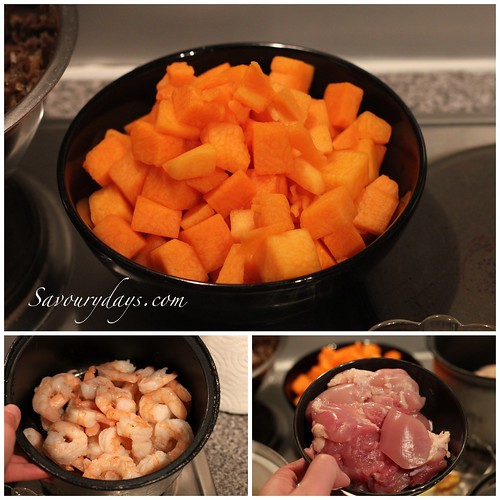
2. Add coconut milk into a sauce pan. Boil over high heat until simmering. Add the curry paste and stir well. Keep boiling for 1-2 more minutes.

High heat is a must to enhance the flavours of the curry ingredients. If the mixture evaporates too fast and the curry mixture dries out too quickly, add more hot water/coconut milk/coconut oil.
The curry paste after being “fried” with coconut milk
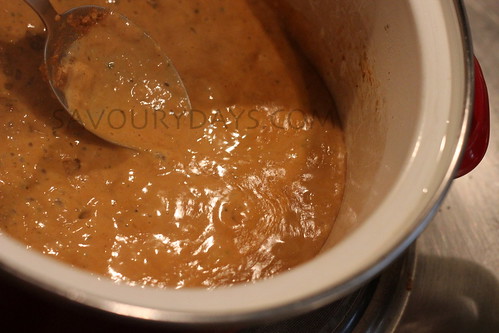
3. Add the chicken. Mix well to let the meat absorb seasonings. Keep the heat at medium-high
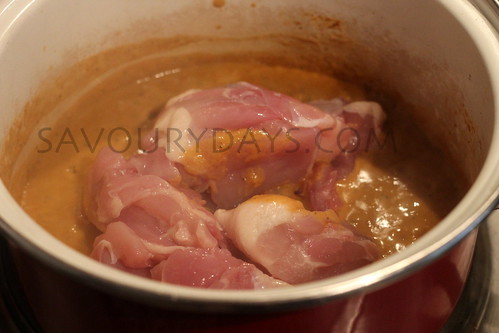
Next, add the shrimp and stir well. Once the ingredients are incorporated, add hot water/broth so that the meat is submerged. Add the lime leaves and lemongrass.
this is the sugar that I used
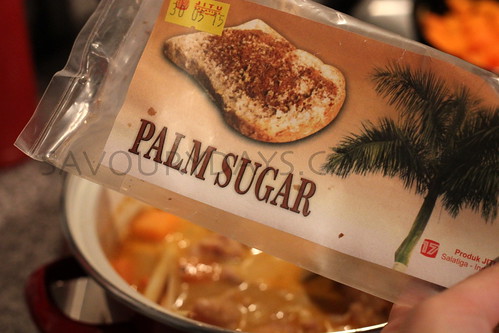
Wait until water starts simmering and remove any unwanted foams. Reduce the heat to low and cook for 10 more minutes. Add sugar and fish sauce according to taste.
4. When the meat becomes tender, turn up the heat to bring the curry to a boil. Add the pumpkin. Reduce the heat to medium and continue cooking for 10 – 15 minutes until the pumpkin is soft. Season well before taking the saucepan off the stove.
Serve while hot with rice and sweet basil.
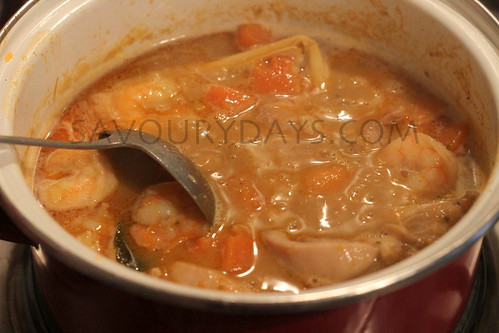
Note
1. The chicken and shrimp can be replaced with beef, depending on your choices. Beef takes longer to cook. If you’re using beef, plain water can be used instead of chicken stock, because the beef itself already has strong flavour.
2. Also, same for veggies: you can add whatever types you like. The most common are aubergines, carrots, zucchinis and mushrooms. Cooking time will vary so make sure you add the veggies into the curry at an appropriate time. Adding too soon will make the vegetables too soft and falling apart, while adding too late will eventually make the meat overcooked.
3. Adjust the amount of coconut milk to taste to reach your desired level of richness and sweetness.
Have a good one!
—————–
- Recipe & Photos: Linh Trang
- Written by: Phương Nguyễn
- Edited by: Thảo Đan

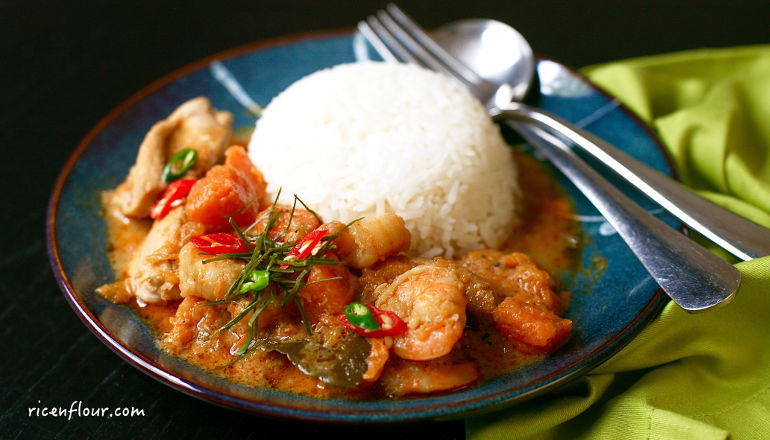


I’ve been to Thailand several times and did a few cooking classes there. Definitely have to try your Panang curry recipe. I basically love all Thai curries, especially the green and red one. So it’s time again to try panang! In Austria, I used to grow my own sweet Thai basil, but here in the U.S. I don’t have any green space, so I have to buy it. It’s hard to find and if you get it at an Asian store, it’s super expensive. Annoying….
Thật tình là rất cảm ơn các bạn đã lập và biên tập trang web này, mình thích nấu ăn và cũng muốn nâng cao vốn tiếng Anh của bản thân. Việc xem các trang web do người nước ngoài viết, mình gặp chút khó khăn vì từ vựng nhiều khi không nắm bắt hết, ngày hôm qua xem trang này, mình thấy rất dễ hiểu. Chúc các bạn thật nhiều sức khỏe để biên tập nhiều bài viết thật hay nữa nhé.